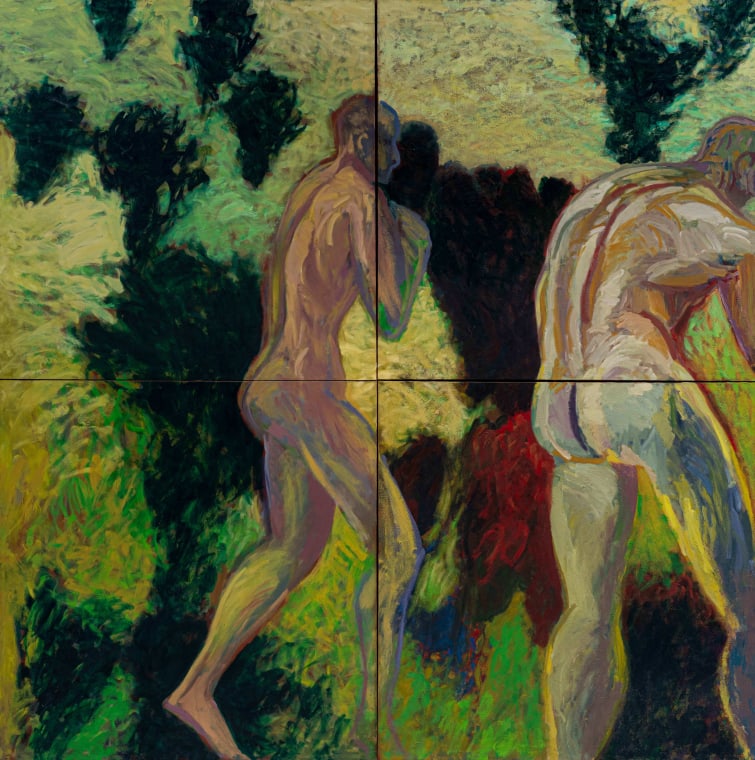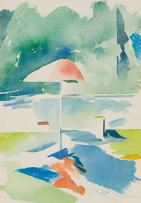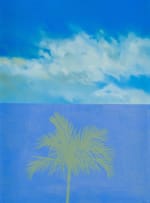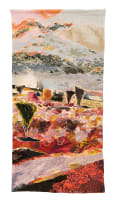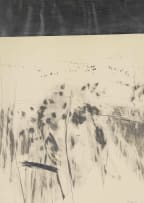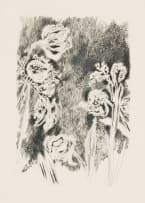Expulsion, quadriptych
Andrew Verster
About the SessionStrauss & Co is delighted to present Andrew Verster: Gorgeous and Free, a landmark timed-online auction devoted exclusively to the celebrated Durban painter, educator, critic, and activist Andrew Verster. This collection serves as a focused snapshot of a prolific career, offering new generations an opportunity to engage with an artist who was a prominent figure in the 1980s. It is a chance to explore a body of work that is deeply compelling and a tribute to the legacy of an artist of such significant contributions.
The 38 lots on offer span the full breadth of Verster's creative output. We are thrilled to present a comprehensive selection that includes his characteristic oil paintings, watercolours, a captivating sculptural door piece, and five monumental tapestries created in collaboration with Stephens Tapestry Studio. Each piece reflects a singular visual language, rich with a distinctive chromatic exuberance and an unapologetic vision.
Leading this outstanding collection is Expulsion, a four-panel tour de force from 1987. This powerful artwork, with its vividly coloured wilderness and hunched male figures, revisits the biblical expulsion from Eden, reinterpreting the narrative through the lens of queer desire. This was a profoundly courageous and dignifying gesture in apartheid South Africa. The aesthetic beauty of Verster’s work often belies the quiet but fearless political messages embedded within, demonstrating how he navigated an oppressive social landscape with subtlety and strength. His bold use of colour and intimate scenes also show a clear debt to painters like David Hockney.
This auction reaffirms Verster’s vital place within a lineage of queer South African painters, including Edward Wolfe and Alexis Preller. This catalogue delves deeper into his body of work and his place in art history, solidifying our commitment to championing significant South African artists.
Incl. Buyer's Premium & VAT
About this Item
signed and dated 88; inscribed with the title on the reverse
Provenance
Estate Late J Jaakke.
Private Collection.
Literature
Clive van den Berg (2020) ArtThrob, Remembering Andrew Verster, online, https://artthrob.co.za/2020/02/28/remembering-andrew-verster/, accessed 31 July 2025.
Notes
Painted in the year Andrew Verster turned 50, the large polyptych Expulsion forms part of a series examining mankind’s fall from grace. It depicts two male figures, both naked, their hunched backs turned to the viewer, exiting a luxuriantly coloured wilderness. The painting revisits the biblical expulsion of Adam and Eve from Eden, a popular trope in Western painting for over a millennium. That the two figures are male in this composition is not incidental. The male nude is a recurring subject in Verster’s diverse output, appearing in his erotic drawings and pop paintings of the 1960s and 70s, as well as in his “riotously chromatic”1 work from the late 1980s onwards. His interest in the nude was not simply formal.
Verster forms part of a rich lineage of queer South African painters, among them modernists like Edward Wolfe and Alexis Preller, who frequently produced nudes. Like Preller, who in 1968 publicly opposed new legislation further criminalising queer life, Verster was openly gay. He purposefully gave dignity to queer desire in his paintings, depicting his male nudes with the same reverence shown by earlier painters for saints. In apartheid South Africa, where the common law crime of sodomy effectively criminalised homosexuality and homophobia was pervasive, this was a courageous political gesture.
Sue Williamson’s entry on Verster in her book Resistance Art (1989), an important survey in which this lot is lavishly illustrated, does not mention the artist’s sexual identity. “As an admirer of his work, I wanted to include him, but beautiful boys on the beach were hard to fit into my theme.”2 Expulsion, with its familiar theme from art history and exquisite colouring, somehow worked. In her entry, Williamson details how, after re-examining unnamed Rubens paintings, Verster felt an urge to produce “heroic work”.3 She perceptively notes that “the movement of the figures away from the viewer and the tight, awkward cropping have more to do with the way the camera has educated the eye than Rubens has.”4 She also hints at the punitive sexual culture of the time when she writes of the hunched figures that they appear “frighteningly aware of an unwanted scrutiny”.5
Williamson had admired Verster’s work since the late 1960s, even acquiring a large triptych of an interior when he showed with dealer Esther Kluk at Gallery International in the 1970s. Verster reciprocated by acquiring two works from Williamson’s A Few South Africans series (Helen Joseph and Winnie Mandela) when they were exhibited at the same gallery in the 1980s. Like Williamson, Verster was a journalist and activist. “As a critic for the Natal Daily News, he wrote about The Modderdam Postcards (1978) etchings when I showed them at the NSA Gallery in 1980, saying they were a breakthrough for me – and exactly what political art should be. I was thrilled and encouraged.”6
1Esmé Berman (1993) Painting in South Africa, Halfway House: Southern Book Publishers, page 291.
2Sue Williamson, email correspondence with the artist, 1 August 2025
3Sue Williamson (1989) Resistance Art in South Africa, Cape Town: David Phillip, page 141.
4Ibid. page 141.
5Ibid. page 141.
6Sue Williamson, email correspondence with the artist, 1 August 2025.
